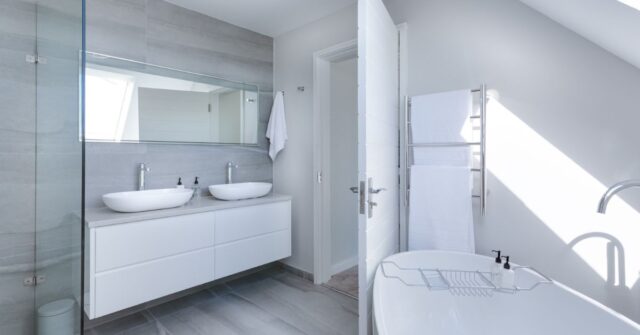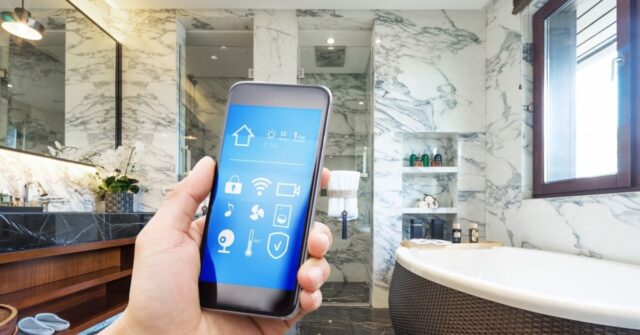Transforming your bathroom into a space that resonates with history, culture, and natural beauty is easier than you might think.
With its deep-rooted traditions and striking visual appeal, Indigenous Australian art offers an extraordinary way to add character and meaning to your home.
Let’s explore how you can integrate these designs into your bathroom while respecting their cultural significance.
Understanding Indigenous Australian Art
Indigenous Australian art is one of the oldest continuous art traditions in the world. It reflects a rich tapestry of stories, beliefs, and customs passed down through countless generations.
By understanding its origins and significance, you can appreciate the depth it brings to your bathroom design and ensure you’re using it respectfully.
What Makes Indigenous Art Unique?
Indigenous Australian art stands out because of its symbolic representations and connection to nature.
These artworks often depict elements like animals, landscapes, and ancestral stories through dots, lines, and earthy colours.
Each piece is a visual narrative, weaving tales of creation, survival, and connection to the land. Adding these elements to your bathroom offers more than just decoration – it brings storytelling into your home.

The Cultural Significance Behind the Designs
Every symbol and pattern in Indigenous art carries meaning, often tied to spiritual and cultural traditions. For example, circles may represent meeting places, while wavy lines can symbolize water sources.
Incorporating these elements isn’t just about aesthetics; it’s about celebrating and honouring a culture that has thrived for tens of thousands of years.
This approach transforms your bathroom into a space of reverence and inspiration.
Stories and Symbols in Indigenous Art
Indigenous art often serves as a visual language, depicting “Dreamtime” stories that explain the creation of the world and the interconnectedness of all things.
When integrated into a modern setting, these symbols can provide a profound sense of place and purpose.
Understanding these stories ensures that your design choices are thoughtful and aligned with their cultural roots.
Why Incorporate Indigenous Art Into Your Bathroom?
Your bathroom is more than just a functional space – it’s a retreat, a sanctuary, and a reflection of your personal style.
Incorporating Indigenous Australian art into this room can infuse it with warmth, character, and meaning.
The Aesthetic Appeal of Indigenous Designs
Indigenous designs bring a distinct and striking aesthetic to any space.
With earthy tones, bold patterns, and natural motifs, they create a sense of harmony and connection to the environment.
These elements can enhance the visual appeal of your bathroom, making it both stylish and inviting.
Enhancing Space With Meaningful Art
Art isn’t just for galleries – it belongs in everyday spaces too. Adding Indigenous art to your bathroom gives it a sense of depth and purpose.
A feature wall or a piece of ceramic art can serve as a conversation starter and a daily reminder of Australia’s rich cultural heritage.
Creating a Unique and Personal Bathroom Environment
Personal touches are what make a house a home. Indigenous art can help you create a bathroom that feels distinctly yours while paying tribute to the timeless artistry of Australia’s First Peoples.
Each piece you choose contributes to a bathroom that’s both personal and meaningful.
How to Respectfully Incorporate Indigenous Art
Incorporating Indigenous Australian art is about more than aesthetics; it requires a commitment to ethical practices and cultural respect.
By being mindful of your choices, you can celebrate this art form in a way that honours its origins.
Sourcing Art and Materials Ethically
Purchasing art directly from Indigenous artists or cooperatives ensures they are fairly compensated for their work.
Look for certified Indigenous products to confirm their authenticity. This approach supports artists and helps preserve their cultural traditions.

Understanding Cultural Permissions and Collaborations
Some designs and symbols are sacred and should not be used without permission.
Collaborating with artists and seeking guidance from Indigenous communities can provide insight into appropriate design elements while fostering mutual respect and understanding.
Consulting With Indigenous Artists and Communities
Working directly with artists allows you to learn the stories behind the designs and incorporate them in a way that aligns with their intentions.
It’s also an opportunity to build connections and support the continuation of traditional art forms.
Practical Ways to Integrate Indigenous Art Into Bathroom Design
There are countless ways to bring Indigenous art into your bathroom.
Whether you’re planning a full renovation or just updating a few elements, these ideas can inspire a harmonious blend of culture and modernity.
Using Indigenous-Inspired Tiles for Feature Walls
Tiles featuring Indigenous patterns or motifs can transform an ordinary wall into a statement piece.
These tiles work beautifully in shower enclosures, splashbacks, or as an accent wall, adding both texture and cultural depth.
Integrating Artworks as Decor Elements
Framed prints, small sculptures, or painted ceramics can bring Indigenous art into your bathroom without major renovations. These items are versatile and can be moved or updated as your style evolves.

Incorporating Indigenous Patterns in Textiles
Towels, rugs, and curtains with Indigenous-inspired designs can add subtle touches of culture to your bathroom. These textiles are a practical and affordable way to embrace this art form.
Blending Indigenous Designs With Modern Bathroom Features
Combining traditional art with sleek, contemporary fixtures creates a stunning contrast.
For example, a minimalist vanity paired with a bold, Indigenous art-inspired mirror frame can balance old and new beautifully.
Choosing Colors and Materials
Colours and materials play a key role in making Indigenous designs stand out. Selecting the right palette ensures a cohesive and visually pleasing result.
Color Palettes Inspired by Indigenous Art
Earthy tones like ochre, terracotta, and deep reds are common in Indigenous art. Pair these with neutral shades like white or beige for a balanced and timeless look.
Natural Materials That Complement Indigenous Designs
Wood, stone, and ceramic materials complement the organic feel of Indigenous art. These elements create a seamless connection between the artwork and the surrounding space.
Ensuring Longevity and Practicality in Design Choices
When choosing materials, consider durability and maintenance. Bathrooms are high-moisture environments, so selecting water-resistant and easy-to-clean finishes is essential.
Design Inspirations and Examples
Looking for inspiration? Indigenous art offers countless possibilities for creating a bathroom that’s both captivating and meaningful. These ideas can help spark your creativity and guide your design choices.
Showcasing Indigenous Art in Contemporary Bathrooms
Modern bathrooms are the perfect canvas for Indigenous art. A large-scale painting or a vibrant tile mural can stand out beautifully against clean, minimalist designs.
The juxtaposition of contemporary fixtures with traditional art creates a striking visual dynamic.
Minimalist Bathrooms With Indigenous Accents
If you prefer simplicity, consider adding subtle touches of Indigenous design.
A single piece of pottery, a patterned bath mat, or even a small framed artwork can bring warmth and personality to a minimalist space without overwhelming it.
Rustic and Natural Aesthetic With Indigenous Art Elements
Indigenous art pairs seamlessly with rustic designs that incorporate raw materials like timber and stone.
Imagine a freestanding stone basin surrounded by walls adorned with hand-painted tiles or carvings inspired by Indigenous motifs.

Ethical Considerations When Using Indigenous Art
Respecting the cultural significance of Indigenous art is crucial when incorporating it into your home. These guidelines will help you honour the art and its creators.
Supporting Indigenous Artists and Communities
Buying directly from Indigenous artists ensures they receive the financial and cultural recognition they deserve. Many artists rely on these sales to support their families and continue their creative traditions.
Recognising and Avoiding Cultural Appropriation
Using Indigenous designs without understanding their meaning or obtaining permission can be seen as disrespectful.
Make sure your choices reflect an appreciation for the culture rather than simply borrowing its aesthetics.
Ensuring Authenticity in Art and Materials
Look for certifications or endorsements from recognised Indigenous organisations when purchasing art or materials. This guarantees that the pieces are genuine and crafted by Indigenous artists.
Benefits of Incorporating Indigenous Art in Bathroom Designs
Indigenous art doesn’t just elevate your bathroom’s aesthetics—it adds layers of meaning and value. Here are some reasons why it’s worth considering.
Fostering Connection to Australian Heritage
Integrating Indigenous art is a meaningful way to celebrate and honour Australia’s First Peoples. It creates a connection to the land and its history, enriching your home with cultural depth.
Creating Spaces That Tell a Story
Every piece of Indigenous art tells a story, whether it’s about creation, survival, or community.
By incorporating these elements, you turn your bathroom into a narrative space that speaks to the beauty and resilience of Indigenous cultures.

Adding Value to Your Home With Meaningful Design
Homes with thoughtful and culturally rich designs stand out in the market. Indigenous art not only beautifies your space but also makes it distinctive, potentially increasing its appeal to future buyers.
Where to Find Indigenous Australian Art for Your Bathroom
Finding authentic Indigenous art and materials is easier than you might think. These sources can help you get started on your design journey.
Reputable Online Stores
Many online platforms specialise in Indigenous art and home decor. Websites like the Indigenous Art Code and authentic art galleries offer a wide selection of pieces, from tiles to paintings, ensuring you’re getting high-quality and ethical products.
Local Galleries and Artisan Markets
Visiting local galleries and markets is a great way to discover unique pieces while supporting your community. These venues often provide opportunities to meet artists and learn more about their work.
Collaborating Directly With Artists
Working directly with an artist allows you to create custom pieces tailored to your bathroom’s design.
This collaboration not only ensures authenticity but also deepens your appreciation for the art and its cultural significance.

Tips for Maintaining and Preserving Indigenous Art in Bathrooms
Bathrooms can be challenging environments for artwork due to humidity and moisture. Here’s how to keep your Indigenous art looking its best.
Protecting Artworks From Humidity and Moisture
If you’re displaying paintings or textiles, ensure they’re sealed or framed appropriately to protect them from water damage. Position them away from direct exposure to steam and splashes.
Caring for Tiles and Textiles With Indigenous Designs
Regular cleaning with gentle, non-abrasive products can keep your tiles and textiles looking vibrant. Avoid harsh chemicals that might damage delicate designs or materials.
Ensuring the Longevity of Your Indigenous-Inspired Bathroom
Invest in high-quality materials and finishes that withstand the test of time. Periodically check for wear and tear, and address any issues promptly to preserve the integrity of your space.
Conclusion
Incorporating Indigenous Australian art into your bathroom design is a journey of cultural appreciation, artistic exploration, and personal expression.
By respecting its significance and thoughtfully integrating its elements, you can create a space that’s not only beautiful but also meaningful.
Celebrate the rich heritage of Indigenous art, and let it transform your bathroom into a sanctuary of stories and style.





